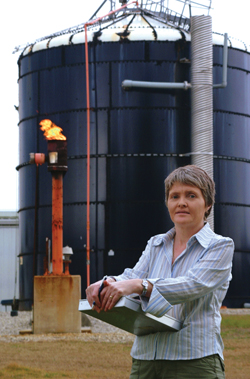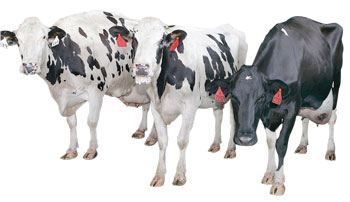|
|
|
 |
|---|
Ann Wilkie records dta at the waste treatment system at UF's Dairy Research Unit in Hague. The fixed-film anaerobic digester tank produces methane gas from flushed manure.
|
As the nation looks to agriculture for renewable fuels from crops and other sources, University of Florida researchers have developed a manure management system that produces energy, saves valuable nutrients for fertilizer, cuts greenhouse gas emissions and stops offensive odors.
“It’s an environmentally friendly solution for an unpleasant housekeeping task,” said Ann Wilkie, an associate research professor with UF’s Institute of Food and Agricultural Sciences. “It’s not often that one technology can solve several major problems, but our innovative animal manure management system is a sustainable option for dairies and other livestock operations that produces renewable energy and protects the environment.”
She said the growing number of big dairy and swine livestock farms — along with urban sprawl in rural areas — has resulted in greater awareness and concern about the proper storage, treatment and utilization of manure. Without proper management, animal manure can get into groundwater supplies, and odor problems can irk nearby residents.
“The key to our waste management system is a natural biological process called anaerobic digestion that relies on microorganisms to transform animal manure into methane gas,” Wilkie said. “Anaerobic digesters, which process waste under oxygen-free conditions, are different than conventional aerobic systems that use oxygen to treat the waste.”
She said anaerobic digesters can process five to 10 times more waste than aerobic systems. Because the waste is enclosed to keep oxygen out, anaerobic digestion keeps odors in. Odors, flies and pathogens are reduced by as much as 95 percent.
With anaerobic digestion, the methane produced can be used to heat water or generate electricity, eliminating greenhouse gas emissions that contribute to global warming. Nutrients such as nitrogen and phosphorus can be recovered and used to fertilize crops.

To demonstrate the technology at a working dairy farm, a large-scale anaerobic digester at UF’s 500-cow Dairy Research Unit in Hague is now generating biogas from manure flushed from animal barns and milking parlors.
About 40 cubic feet of methane per day can be produced from the waste of each dairy cow, Wilkie said. Each cubic foot of methane has about l,000 BTUs, which adds up to a huge amount of usable energy.
Art Darling, executive director of Sunshine State Milk Producers Inc. in Orlando, said although methane technology is not cheap, it can solve important energy and environmental problems on Florida dairy farms.
Darling said the UF system takes advantage of the fact that it is less expensive to move liquid containing manure than dry manure solids. The anaerobic digester processes manure from the large volumes of water used to flush waste from animal holding areas at the dairy.
Because manure flushed from these areas is so diluted by water, only two types of anaerobic digesters are practical for Florida dairies – covered lagoons and fixed-film digesters, Wilkie said. Covered lagoons require large land areas, gas-tight covers and careful sealing to prevent nutrients from leaching into groundwater. By contrast, the fixed-film anaerobic digester at Hague is a 100,000-gallon tank that has a relatively small footprint, which can be a real plus when local land-planning issues are a concern, she said.
Ann Wilkie, acwilkie@ifas.ufl.edu
Chuck Woods
